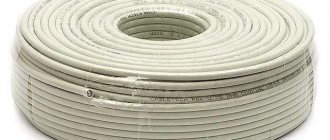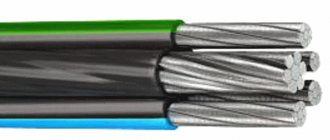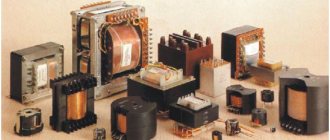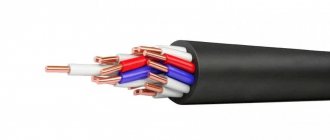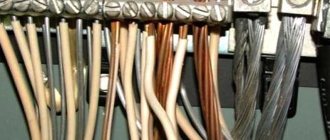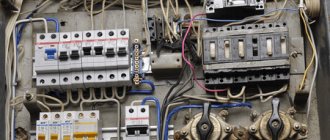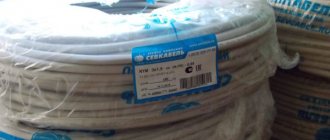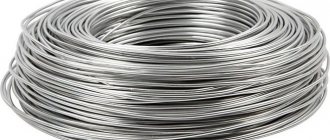How long does indoor electrical wiring last: GOST standards
Government standards establish the nominal service life of electrical wiring. This indicator indicates the time during which the cable provides power supply under operating conditions. The nominal period is theoretical, used when creating a house project and differs from the real one.
The warranty period is set by the manufacturer. It is less than nominal and is guaranteed for 10 years. If a cable breakdown occurs during this time, the manufacturer undertakes to replace it free of charge.
Replacement is made only if several conditions are met:
- There are no disturbances during cable transportation.
- Installation was carried out by a professional electrician with the appropriate license.
- Operating conditions were not violated.
Warranty is void if excessive voltage or current is applied.
Actual service life - this indicator determines the actual time of use of the wires. Actual usage time depends on correct installation, correct wiring, compliance with electrical regulations, supply of specified power and other requirements. If the conditions are met, electrical wiring may last longer than its rated value. If violated, the service life is reduced.
Rated life
This is a combination of factors that ensure the working condition of the product. There are upper and lower limits for the rated life.
For example: NYM cable is used for installation of electrical wiring both in everyday life and in industry. Can be used both indoors and outdoors. The cable is designed for an operating voltage of 0.66 kV and can operate stably at temperatures from -50 to +50°C. Under these conditions, the cable has a service life of 30 years. However, the manufacturer provides a 5-year warranty. This means that if within 5 years the cable, while maintaining the nominal parameters in operation (0.66 kV at a temperature from -50 to +50°C), loses its functionality, then the manufacturer is obliged to ensure its replacement.
Cable lifespan
Cable material is the most important characteristic on which the operating time of electrical wiring depends. There are two types of materials used for electrical wires in homes: copper and aluminum.
Copper
Copper conductors are preferred over aluminum conductors. This is determined by the characteristics of copper - it has a lower resistivity, greater electrical conductivity, and can withstand a greater load with the same cross-section. The nominal service life of copper cable is 20-25 years.
The cost of copper wire is higher than aluminum.
Aluminum
The use of aluminum wires in home electrical wiring is not advisable. According to the rules for electrical installations, aluminum cables are used in temporary buildings and structures with a service life of no more than two years. Aluminum wires become brittle over time and break quickly, stretch over time; in terms of technical characteristics, they are significantly inferior to copper.
But aluminum also has advantages - it is a lightweight material that is resistant to corrosion, as it forms a protective film when interacting with air. The nominal service life is 15-20 years.
There are some nuances that should be taken into account when working with the electrical network:
- the connection of copper and aluminum conductors is a weak point in the wiring;
- partially replacing a section of wiring in order to increase power will not yield results;
- economic feasibility - if the electrical wiring does not require reinforcement, there is no point in replacing copper conductors with aluminum ones.
When working with aluminum, preventive maintenance should be carried out every two years: tighten the clamping screws, strengthen the loose contact.
Shelf life of cable and wire
Any technical product has its own service life or shelf life. There are no parts that last forever, so the concept of an unlimited shelf life is completely eliminated. The more heterogeneous materials there are in a product, the less it will serve its owner. Cable products also cannot be used or stored indefinitely. Each variety has its own period during which it can be used for its intended purpose or stored in a warehouse. This depends on the material of the core, sheath, and also on certain external conditions.
Why do manufacturers give little warranty?
This is because they want to absolve themselves of liability if the buyer violates the terms. Therefore, a period is always laid down that the product will withstand in the presence of the most unfavorable factors. In practice, everything is extended many times, especially if the installation is carried out by experienced electricians. For most cables and wires, precise operating conditions are prescribed. Usually this is a dark, dry place with a certain temperature regime. It is for these reasons that you cannot use cables that have simply been lying around in the open air unattended for a long time. The product may look normal, but it will still not have the necessary characteristics and will also be too dangerous.
What experts say
It is believed that overheating of cables beyond the maximum permissible values by the manufacturer should not be allowed. So-called residual plasticization can occur in polymer shells. This means that materials become significantly more brittle compared to their original state. Loss of plastic properties does not mean dynamic brittleness. Vibrations are constantly present in buildings, which cause cracks. Then the insulation crumbles, causing exposure and a short circuit. Therefore, the shelf life of wire and cable is a relative concept. It all depends on the engineers and the owner of the building or structure.
Copper is the preferred option for long-term storage. Aluminum often loses its structure, oxidizes, and also decomposes into a whitish oxide, which increases the fragility of the structure. This phenomenon often occurs in damp areas or during prolonged exposure to high temperatures. Copper is darker, but the main core does not lose its conductivity. This is why it is often the preferred option. Therefore, when choosing, you need to understand that aluminum conductors are cheaper, but they fail over time. An example is the copper cables that have been lying in the ground since the 1950s. For example, these are underground power lines for urban electric transport.
How to increase the service life of electrical wiring in an apartment building
The most important condition for long and reliable operation of the wiring is compliance with all operating standards:
- it is important to prevent overloading of wires and voltage surges;
- installation and installation of conductors should be carried out by a professional;
- Additional insulation can also extend the operating time - a double layer increases the service life of the aluminum wire up to 30 years;
- for aluminum cable, the cross-section must be at least 16 sq. mm;
- It is recommended to use clamp contacts and a special lubricant that protects the wires from oxidation;
- wires should be selected taking into account the total power of the connected devices - conductors for powerful devices should be thicker than for lamps or other low-power units;
- use welding of conductors in junction boxes.
It is also important to follow fire safety rules. The conductors should not be exposed to moisture; at the slightest damage, the non-functional section must be replaced.
The service life of electrical wiring depends on many factors. Subject to operating conditions, the wiring will not require repair or replacement for many decades.
Basic operating requirements
If you nevertheless decide to use aluminum wiring in an apartment or private house, consider the following requirements:
- Cross section of at least 16 square meters. mm (we already talked about this, but it wouldn’t hurt to remind you).
- Use clamp contacts (as well as a special lubricant that will prevent contact oxidation and keep contact resistance low).
- Use welding of aluminum electrical wires in distribution boxes (requires a large investment of time and money, so it is rarely used). If you do not carry out the work yourself, monitor the work of electricians in your home and monitor the process to ensure that all technical aspects are adhered to.
It will also be useful for you to know the maximum load on aluminum wires of different sections. We provided all the data in the table:
And remember, regardless of the type of wiring in your home, adhere to fire and electrical safety rules, as well as operating rules. This way you can protect your family and your home from unwanted consequences and accidents. Finally, we recommend watching another useful video on the topic:
That's all I wanted to tell you about the pros, cons and dangers of using aluminum wiring. We hope you have weighed the pros and cons, and then made the right choice in favor of safety.
We also recommend reading:
Rough electrical work refers to cables and their connections to each other. Rough electrical wiring can be laid both on the surface and in the form of hidden wiring, embedded in walls or floors. Finish electrics include all kinds of sockets and switches that are mounted exclusively on the surface.
The service life of electrical wiring is divided into nominal, actual and warranty.
How long should the warranty period be for electrical wiring?
The warranty period for electrical wiring must be at least 10 years. If you, as a customer, are given a warranty of less than 10 years, then you definitely should not contact such “specialists”. Rough electrical installations must withstand at least five renovations and repairs. These updates are carried out every 5-7 years.
Thus, even under the most severe operating conditions, rough electrical equipment should last at least 50 years. After the nominal service life has expired, the network is re-tested under load. If, as a result of such testing, an electrical breakdown of the cable occurs, it is replaced. If the cable has withstood the load, then its operation continues. There are objects where old aluminum wiring has served for more than 70 years.
Modern cables in combination with spring terminals can work for at least 100 years without problems. Currently, the electrical cable is being tested on special test benches.
Test stands are mechanisms that simulate operation in conditions as close as possible to the real ones. Thanks to bench testing, it is possible in a very short time to fairly accurately predict what will happen to the cable after 10, 30, 50 and even 100 years of operation.
Test stands are designed for both cable testing and testing of its connections. Stands are enclosed spaces in which cables are laid in walls, corrugations, or simply in open connections. The cable is subjected to all kinds of stress. Such as may occur under real operating conditions. These are current loads, temperature changes, and humidity changes. A cable that has passed all tests is subject to further use without the need to replace it.
When installing new wiring, the owner of the premises strives to do everything so as not to return to this operation, therefore, when carrying out repairs or during the construction process, he is always interested in how long the service life of the wire is. At the same time, confusion often arises in defining the very concept of service life - designers, cable manufacturers and electricians operate with different numbers. Therefore, first, let’s define the terminology.
